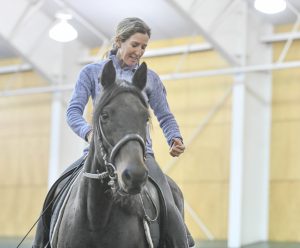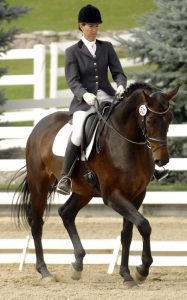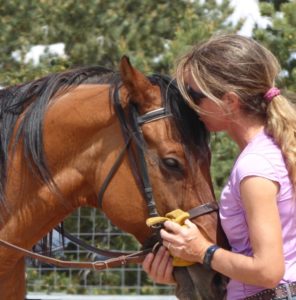Editor’s Note: Best Horse Practices Summit presenter Katrin Silva grew up riding dressage in Germany before moving to the United States at age 19 to learn to ride Western. She’s been riding both disciplines for the last 20 years and is a regular guest columnist for Cayuse Communications. The author of Dressage for All of Us: How to Help Any Horse Become a Happier, More Responsive Riding Partner lives in New Mexico where she works with dressage and Western clients.
Katrin’s upcoming book is Feel for All of Us, due in early 2022. Read more about that here.

Katrin Silva at the 2019 Summit. Photo by Nina Fuller
Katrin writes:
All of us have seen horse-rider pairs who look competent, yet something is missing: that difficult to define quality we call connection or harmony. We all have seen riders who communicate with their horses, but only in the sense that they tell the horse what to do. The horse may be obedient in a mechanical sort of way, but she lacks expression. Such riders may be successful, but they don’t make us say “Wow!”
On the other hand, we’ve also have seen horse-rider pairs who understand each other on a deeper level – for a moment, for a minute, or for longer. The horses look like they’re enjoying themselves, like they’re engaging with their riders instead of just following orders. At competitions, I’ve experienced a few of these moments of real connection, but more often during quiet, otherwise unremarkable rides, on unremarkable horses. I’ve also seen my students connect with their horses, sometimes during lightbulb moments in lessons, but more often when they’re just enjoying their horse time.

Katrin Silva
Is it just luck and coincidence or can we make these moments happen more frequently?
The secret ingredient that creates harmony between horses and riders, is feel. Feeling riders are truly good riders, rather than merely educated or competent ones. But what, exactly, is feel? And what is the role of feel in the horse-human connection?
Riding is a two-way conversation. The technical knowledge of how to talk to your horse, which aids to give so the horse knows which maneuver to perform, is one part of this process. The other more important part consists of listening to the horse’s side of the story. It’s our willingness and ability to understand what the horse is telling us at any given moment. This is what we call feel.
Whenever we listen, horses tell us all sorts of things. Perhaps most importantly, through feeling the relaxation or tension in the horse’s back and neck and jaw, in the horse’s consistent or variable rhythm and tempo, we are feeling the horse’s mind. We can tell whether or not he is feeling secure with us, whether or not he feels confident in his surroundings and in our presence on his back. When we ride with feel, we can tell what a horse will do a fraction of a second before he actually does it. Riding with feel makes us safer. A feeling rider can tell when a horse is about to spook or buck, and she can take measures to prevent or minimize it. When I feel a horse become tense during a training session, I can allow him to stretch forward and down, or give him a walk break. When I feel a horse’s attention wander in a new environment, I can bring his focus back to what we’re doing.
 It’s relatively simple to learn the correct aids. The challenging part is learning how light or strong of a signal to give, and exactly when to give it, and when to stop giving it. Only a feeling rider can ask the horse for a transition at the right moment – or not ask for the transition when she feels that it would not be good if she asked for it at that very moment instead of a couple of strides from then.
It’s relatively simple to learn the correct aids. The challenging part is learning how light or strong of a signal to give, and exactly when to give it, and when to stop giving it. Only a feeling rider can ask the horse for a transition at the right moment – or not ask for the transition when she feels that it would not be good if she asked for it at that very moment instead of a couple of strides from then.
An essential part of feel is timing. Timing is what makes transitions smooth. Timing is what makes good riding look like a dance, with both partners participating.
On a larger scale, timing is also about knowing whether a horse is ready for schooling flying changes or lateral work. A rider without feel will go by established guidelines: the training scale of dressage, for example. These guidelines are valuable general rules, based on decades, or centuries, of accumulated experience. They deserve consideration and respect from us, but so do the individual conformation, personality, and training history of each horse. The training scale is not set in stone. A feeling rider will recognize when a horse is ready to try a more advanced movement, maybe only for a few steps. A feeling rider will also realize when a horse is not yet ready for a certain level of training in spite of conventional wisdom saying he should be.
So yes, feel is a key element of good horsemanship. And yes, many riders, even experienced ones, don’t have feel. But I disagree with the conclusion that feel is something you either have or don’t have, something gifted riders are born with and and less gifted riders learn to live without.
 The concept of feel can sound like a holy grail. I’ve heard a couple of clinicians say, or imply, that the riders they teach will never have feel, that they can’t hope to ever reach this level of connection. I’ve also heard their students agree with the assessment that feel is reserved for those select few with natural talent. Feel becomes something elusive that those of us who lack it will never grasp. Many of us believe that we just have to accept our place in the horse universe as riders with limited potential.
The concept of feel can sound like a holy grail. I’ve heard a couple of clinicians say, or imply, that the riders they teach will never have feel, that they can’t hope to ever reach this level of connection. I’ve also heard their students agree with the assessment that feel is reserved for those select few with natural talent. Feel becomes something elusive that those of us who lack it will never grasp. Many of us believe that we just have to accept our place in the horse universe as riders with limited potential.
This story has been told so many times by so many people that it sounds true. But it isn’t. I was not born with feel or with any natural talent for connecting with horses. But I learned how to feel, which means you can, too. Feel is something anyone can develop, with enough practice, the right kind of horse, in the right kind of setting, with the right kind of guidance from the right kind of teacher.
Ultimately, the biggest obstacle standing in the way of feel is very simple: we believe we can’t learn feel, so we don’t try. This is what we need to change, more than anything else. It’s crucial for riders to believe they can learn feel and that teachers can help them develop it. Feel is for all of us.
Excellent observation and very helpful article. It’s frustrating to hear people say there are “natural” leaders, athletes, etc. who are just born with a skill or ability, and because of this will always outshine than those who are not.
Thank you for debunking the myth and encouraging us all to be better riders!
Kehaulani, I think there are athletes with a bit more naturall talent than others, but that’s not what matters in the long run, especially for equestrians. Talent may give you a little bit of an edge early on, but if you lack other qualities, like empathy, resilience, patience, and a good work ethic, you will never become a good rider. Talent in and of itself will not make anyone a horsewoman or horseman. Only long years of experience with the right kind of guidance will do that. Thank you for commenting!
I love to hear this. I believe this is not merely a component of mechanically managing the horse; but a step towards the maturity of the human into the relationship. I have seen that the horse people I most admire have achieved a certain technical ability of course; but there is a sense of release into the dance that results in something truly beautiful.
It was a pleasure meeting you the this year’s Summit! I will be following you, and hope we meet again.
Stephanie, I hope we meet again soon! I love your way of describing a good horse-rider relatonship.